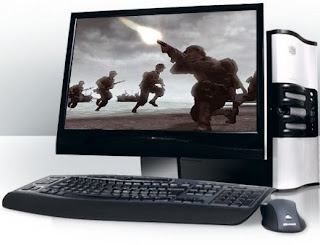 PC gaming is a world all its own. With
many people spending thousands of dollars on video cards alone, maximum
performance is what the ultimate gaming computer is all about. With no room for
compromise, only the best of the best components will be featured in the
ultimate gaming computer. These will provide the user with unparalleled
performance that will maximize their ability to play to their best abilities at
any time.
PC gaming is a world all its own. With
many people spending thousands of dollars on video cards alone, maximum
performance is what the ultimate gaming computer is all about. With no room for
compromise, only the best of the best components will be featured in the
ultimate gaming computer. These will provide the user with unparalleled
performance that will maximize their ability to play to their best abilities at
any time.
When choosing components for the
ultimate gaming computer, price is clearly no object. However, the type of
setup a user is going for, whether maximum single monitor performance or 3d
surround performance spanning three high-resolution monitors, will greatly
affect what will be required for acceptable frame rates during play. Although
every component in a gaming computer is important for maximum performance, the
GPU and power supply will play a vital role in your gaming experience.
Avoiding Bottlenecks
Purchasing a processor for a gaming
computer doesn't have to be a difficult. With many options available that
provide quad-core processing, you'll be able to unleash the power of your GPUs
with minimal effort. However, choosing a motherboard can be an entirely
different monster of its own. If you're only looking to use a single GPU in
your gaming machine, purchasing a more affordable motherboard that features
only a single PCI Express 2.0 or 3.0 slot will serve you well. These
motherboards will allow any GPU to work to its full potential without
bottlenecking it via less PCI Express lanes.
If you're looking to unleash a TRI-SLI
or Crossfire monster, then purchasing a motherboard that features two or three
PCI Express 3.0 slots that all work at full 16x speed while occupied and paired
with a processor that supports the lanes is a must. While some motherboards may
boast two or three of these slots, they will often cut the lanes available for
data to travel through to 8x per slot. For a motherboard featuring PCIx 3.0
slots, this will not affect performance more than a few percent. However,
motherboards featuring PCIx 2.0 slots can suffer greatly when the available
lanes are cut from 16x to 8x while using the latest graphics cards offered.
Understanding Your Graphical Requirements
Once you've narrowed down your
motherboard and processor choices, choosing a GPU is next. There are a few
things to consider when choosing a GPU. If you will only be utilizing one
monitor with a resolution of 1920x1200 or 1920x1080, a single powerful GPU that
features 2GB of VRAM will be more than sufficient to ensure you get maximum
performance in your games. However, if you'll be utilizing a single 2560x1600
or 2560x1440 resolution monitor, choosing a graphics card with more VRAM can
help to avoid running out of VRAM when high resolution textures are put to use.
In addition to VRAM, the processing power of the GPU is very important. Always
compare the number of processing cores and the speed at which they run to
ensure you're getting the most bang for your buck.
Unleashing The Beast
Anyone looking for the best performance
across three high resolution monitors at the same time will want the best GPUs
available. For these massive resolutions, the more VRAM you can squeeze in, the
better. With many graphics cards now available with 2GB, 3GB and even 6GB of
video ram, you can choose a card that fits your purpose and budget. However,
for triple monitor setups, SLI/Crossfire and Tri-Sli will give you the maximum
performance you're looking for. Remember, this amount of rendering power comes
with a price. You should always ensure that your new gaming computer is
adequately powered by a PSU that meets the demands of the entire system without
straining itself.














0 comments:
Post a Comment